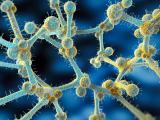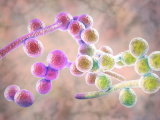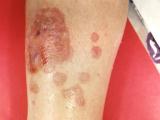Oct 10, 2012 (CIDRAP News) – The number of patients sickened in a fungal meningitis outbreak linked to steroid injections for back pain rose to 137 today, including one more death, and clinicians are facing tough decisions about how to manage patients in light of unusual features of the outbreak.
In its latest update, the US Centers for Disease Control and Prevention (CDC) said it has received reports of 18 more cases since yesterday, along with news of another fatality, which raises the number of outbreak-related deaths to 12. The number of states reporting cases remained the same at 10.
A CDC conference call for clinicians today drew 2,000 participants, which the presenters called an "overwhelming response." Two of the CDC's experts were on hand to share the latest information on the illness and field many questions from health workers, ranging from pain clinic employees worried about their patients to an emergency department physician overwhelmed by the number of patients exposed to the recalled drug who are experiencing symptoms and need lumbar punctures to check for evidence of fungal meningitis.
The CDC experts included Melissa Schaefer, MD, a medical officer who works on ambulatory care and healthcare-related infection issues, and Tom Chiller, MD, MPH, a medical epidemiologist whose study emphasis has included fungal diseases. Both are with the CDC's National Center for Emerging and Zoonotic Infectious Diseases.
Schaefer said the CDC is coordinating active outreach to patients exposed to one of the three recalled lots of preservative-free methylprednisolone acetate that have been implicated in the outbreak. She said 75 facilities in 23 states received the medication and that about 13,000 patients had at least one injection from one of the lots.
Some patients also received joint-space injections with the recalled steroids, but she said so far the CDC hasn't received any reports of infections related to those procedures.
The CDC's investigation and clinical guidance are evolving quickly, and she advised health workers to consult the CDC's outbreak Web page for daily updates.
Chiller said testing so far has confirmed that 10 of the infections involve Exserohilum, a type of black mold. "A rare and unique mold—not something we have seen causing meningitis previously," he said. Tests have also identified Aspergillus fumigatus in one patient's samples.
He said officials still don't know if other types of mold are involved in the outbreak, a factor that—combined with unusual Exserohilum meningitis infections—makes it a challenge to craft treatment recommendations. For now, the CDC is recommending powerful doses of two antifungal drugs for infected patients that can penetrate the central nervous system and provide broad coverage against a range of fungi.
The CDC officials said experts are also wrestling with what to tell clinicians about the incubation period. Some patients have gotten sick after just 4 or 5 days, while others clearly started having symptom beyond 4 weeks, which was initially thought to be the outer limit of the incubation period.
"We know that fungi can be indolent and progression can be slow," Chiller said.
Health officials are still collecting and analyzing information about the illnesses, Chiller said, but so far, the most common presenting symptoms seems to be headache, neck pain, nausea, and new neurologic deficits.
For the fatal cases, they said so far the most frequent cause of death is stroke or a complication of stroke. Schaefer and Chiller emphasized that the analysis of cases is still in the early stages, so it's difficult to make definitive statements about the illness features and treatment protocols.
As the clinical picture continues to evolve, they urged clinicians to aggressively seek a diagnosis in suspected cases and to check the CDC's Website each day for changes in recommendations as the outbreak and its investigation unfold.
See also:
Oct 10 CDC outbreak update
CDC Clinician Outreach Community Activity (COCA) Web page




















